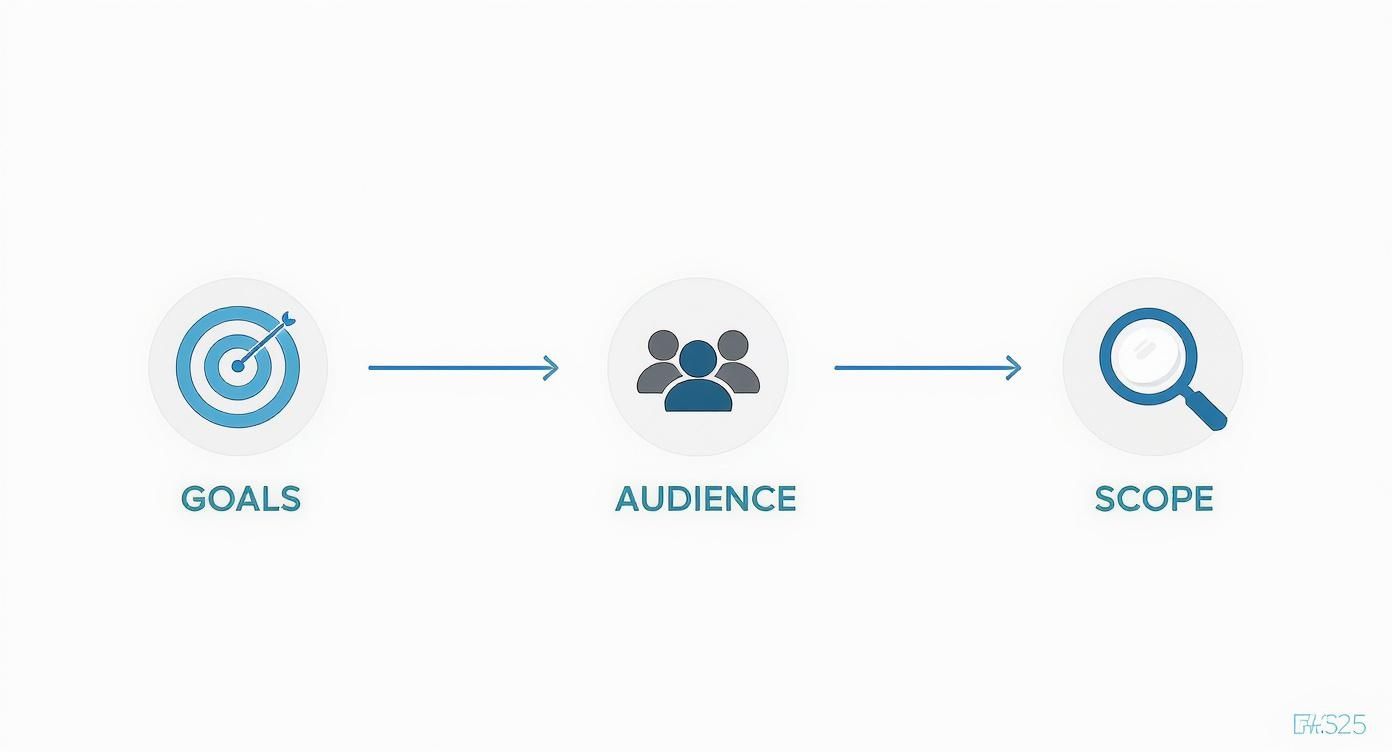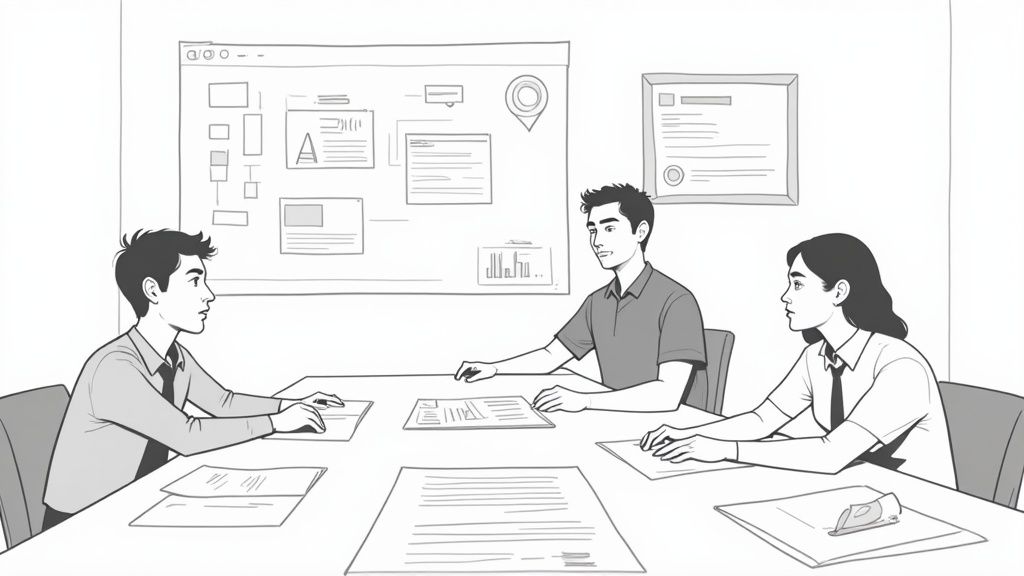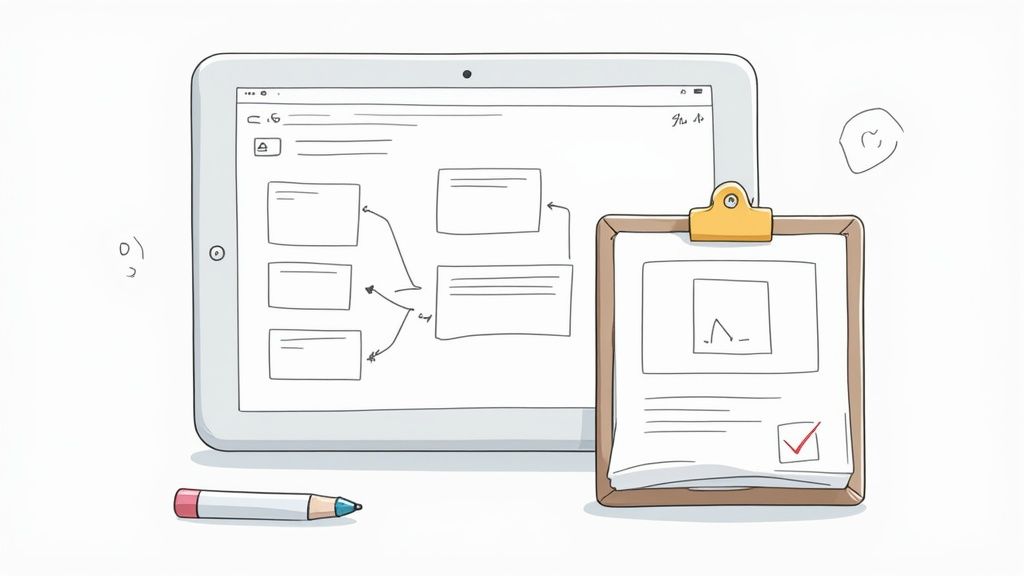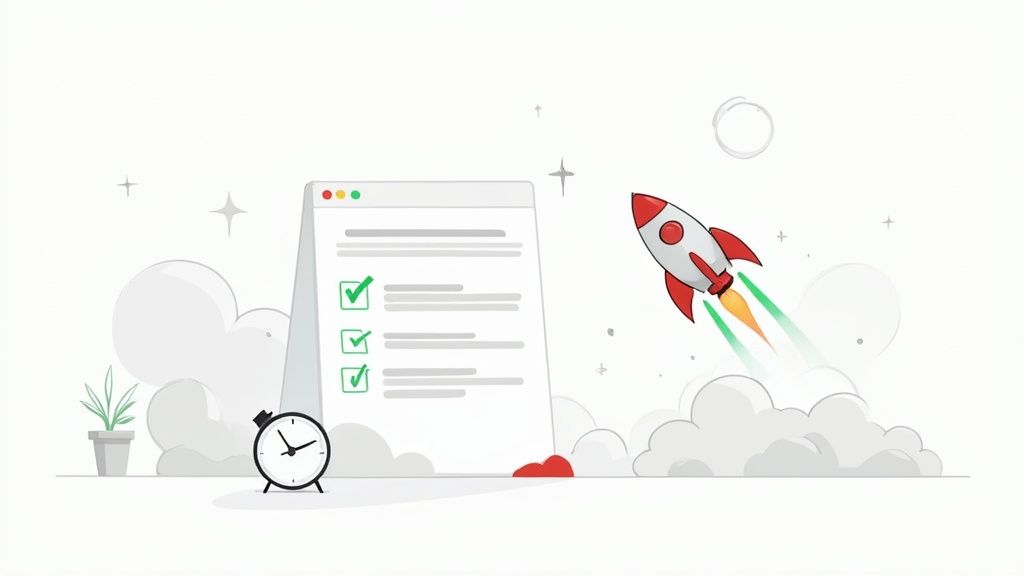
A solid web design process is what turns a creative spark into a website that actually works for your business. It’s a structured journey that takes you from the initial “what if?” all the way to launch day and beyond, making sure every decision is smart, user-focused, and tied directly to your goals. Without it, you’re just inviting scope creep and budget blowouts.
Laying the Groundwork with Discovery and Planning
Every great website begins long before anyone touches a line of code or picks a colour palette. This first phase is all about deep-dive discovery and solid planning. It’s where you define the project’s direction and, honestly, prevent most of the costly mistakes that can derail things later on.
Skipping this part is like trying to build a house without a blueprint. You might end up with something standing, but it almost certainly won’t be what you needed.
The whole thing kicks off with proper, in-depth stakeholder meetings. The goal here is simple: get everyone on the same page about the website's primary purpose. Is it here to generate leads? Sell products directly? Act as a resource hub for existing clients? Nailing this answer shapes every single decision that follows.
Defining Your Audience and Competitors
Next, you need to get inside the heads of the people who will actually be using the site. This is where creating detailed user personas comes in. It helps you understand their real needs, what frustrates them, and how they behave online.
This insight is absolutely critical for designing a site that resonates and feels genuinely useful. For example, a website for a financial advisor targeting retirees will look, feel, and function completely differently from one aimed at tech-savvy millennials.
At the same time, a thorough competitor analysis helps you spot opportunities. By looking at what your rivals do well—and, more importantly, where they’re dropping the ball— you can find gaps in the market. This isn’t about copying them; it’s about learning from their wins and failures to find your own unique angle.
Key Takeaway: The discovery phase isn't just about ticking boxes and gathering info. It's about building a shared understanding of the project's 'why' that will act as a compass for the entire team through the complexities ahead.
The infographic below really nails the core flow of this crucial first stage.

As you can see, defining goals, understanding the audience, and getting the scope right are all interconnected pieces of the foundation.
Finalising the Project Scope
With all this information in hand, you can put together a detailed project brief. Think of this document as the project's north star. It needs to clearly outline:
- Project Goals: What the website absolutely must achieve.
- Target Audience: Exactly who the website is for.
- Key Features & Functionality: What the website will do.
- Timelines & Milestones: A realistic schedule for getting it all done.
Defining a rock-solid scope is your best defence against "scope creep"—that slow, painful process of a project expanding way beyond its original objectives. This is where sharp project management becomes invaluable. You can explore some proven strategies for keeping things on track in our guide to successful website project management.
Finally, now is the perfect time to get started on keyword research and content strategy. Building a site with a strong SEO foundation from day one isn't optional anymore; it’s essential for long-term visibility and success.
Mapping the Blueprint with UX and Wireframing

With a solid plan locked in, we move from abstract ideas to a tangible structure. This is where we get into the nuts and bolts of user experience (UX), building the website's skeleton with a laser focus on how it will actually work for the end-user.
Think of it as the architectural blueprint stage for a house. Before you even think about paint colours or furniture, you have to decide the layout of the rooms, the flow between them, and where the doors and windows will go. This foundational work ensures the final result is logical, intuitive, and easy to live with.
Structuring the User Journey
First up is the sitemap. This is a high-level diagram showing every page on the website and, crucially, how they all connect. It gives a clear, bird's-eye view of the site's architecture, helping to organise everything logically so users can find what they need without getting lost in a maze of pages.
From there, we drill down into user flows. These are much more detailed paths that a typical visitor might take to complete a specific task, like buying a product or filling out a contact form. Mapping these journeys helps us spot potential friction points and streamline the experience long before a single pixel of design is created. As you start to map out your site, it’s vital to optimize user experience for better engagement.
Expert Tip: Don't overcomplicate your navigation. A user should know where they are and how to get where they want to go within seconds. If your menu needs a manual to be understood, it's already failed.
Creating Low-Fidelity Wireframes
Wireframes are the next step—simple, black-and-white layouts that focus purely on functionality and content hierarchy. They deliberately leave out colour, fonts, and images to stop everyone from getting distracted by visual aesthetics. Their only job is to answer one question: "How is this page going to work?"
This low-fidelity approach is brilliant because it allows for rapid changes. It's far cheaper and faster to adjust a few boxes on a simple diagram than it is to rework a fully designed mockup. The focus stays squarely on the core elements:
- Layout: Where key components like headers, footers, and content blocks will sit.
- Functionality: How interactive bits like buttons, forms, and menus are going to behave.
- Content Priority: What information is most important on the page and needs to be featured prominently.
This intense focus on UX has grown massively, with around 52% of UK companies now prioritising developers with strong UX/UI skills. This shift shows that the market realises seamless user interaction isn't a nice-to-have; it's a key driver of business success.
Getting this structure right early on saves an incredible amount of time and money down the line. For more detailed guidance, check out our article on how to improve website user experience.
Bringing the Vision to Life with UI Design
Once the blueprint gets the nod, the real visual magic begins. This is the part of the web design process where those functional wireframes start to look and feel like a real website, transforming from a structural skeleton into an engaging, stunning experience with a personality that connects with your audience.

The User Interface (UI) phase is all about bringing your brand's aesthetic to life. It often kicks off with mood boards—carefully curated collections of images, colours, fonts, and interface examples that capture the desired look and feel. This simple step gets everyone on the same page visually before a single pixel is pushed in a detailed design.
Developing a Consistent Visual Language
From that mood board, a proper style guide is born. Think of this document as the single source of truth for the site's visual DNA, ensuring that every page, button, and icon looks like it belongs. A well-organised style guide is absolutely non-negotiable for a professional, polished finish.
It usually locks down the essentials:
- Colour Palette: Defines the primary, secondary, and accent colours, complete with their specific hex codes.
- Typography: Sets the rules for headings, body text, and links, including font families, sizes, and weights.
- Imagery: Gives clear guidelines on the style of photography or illustration that should be used.
- Iconography: Establishes a set of custom or library icons that perfectly match the brand’s style.
This guide acts as a rulebook for both designers and developers, stopping inconsistencies from creeping in as the project gets bigger. Understanding a solid User Interface Design Framework is also invaluable here, as it provides a structured way to build design systems that are both scalable and easy to maintain.
A style guide is the key to maintaining brand consistency, especially as a project scales or involves multiple team members. Below is a breakdown of the core elements that every style guide should include.
Key Components of a Website Style Guide
| Element | Description | Example |
|---|---|---|
| Colour Palette | The primary, secondary, and accent colours, including specific hex codes. | #1A2B3C (Primary), #4D5E6F (Secondary), #FFC107 (Accent) |
| Typography | Font families, sizes, weights, and line heights for headings, body text, and links. | Heading 1: Poppins Bold, 48px. Body: Lato Regular, 16px. |
| Iconography | The style and set of icons used for navigation, features, and actions. | Solid, line-art icons from a specific library like Font Awesome. |
| Imagery Style | Guidelines on photography or illustrations, including tone, subject, and composition. | Use warm, candid lifestyle photos featuring natural light. |
| UI Components | The design of buttons, forms, cards, and other interactive elements. | Primary Button: Blue background, white text, 4px border-radius. |
| Spacing & Grid | Rules for margins, padding, and the layout grid system to ensure visual rhythm. | Use an 8px grid system for all spacing measurements. |
By defining these elements upfront, you create a powerful toolkit that speeds up the design process and guarantees a cohesive user experience across the entire website.
A great UI isn't just about looking pretty; it's about visual communication. Good design guides the user's eye, makes information digestible, and uses visual cues to encourage actions, like clicking a "buy now" button.
Merging Design with Content
Even the most beautiful design will fall flat if it doesn't support the content. During the UI phase, the design and the copy have to work in perfect harmony. Layouts are carefully crafted to make text easy to scan, with plenty of white space to prevent visual clutter and boost readability.
Calls-to-action (CTAs) are designed to stand out and are strategically placed to draw the user's attention, making it crystal clear what their next step should be. This synergy between visual hierarchy and compelling copy is what turns a passive visitor into an active customer. For those looking to dive deeper, our guide on website design best practices offers more tips on creating effective, user-friendly layouts that get results.
Building the Engine with Code and Development
This is where the magic really happens. Up to this point, we've been working with blueprints and static visuals. Now, it's time to give them a pulse. The approved designs are handed over to the development team, who meticulously translate every pixel into a living, breathing website that people can actually click, scroll, and engage with.
The build is typically split into two distinct but tightly connected areas: the front-end and the back-end. Think of it like building a high-performance car. You need both a beautifully crafted chassis that people admire and a powerful, reliable engine under the bonnet to make it go.
Crafting the User-Facing Experience
Front-end development is all about what you see and interact with in your browser. Our developers use a core trio of languages to bring the designs to life:
- HTML (HyperText Markup Language): This forms the fundamental structure of your site—the skeleton holding all the headings, paragraphs, and images together.
- CSS (Cascading Style Sheets): This is the styling language. It controls the colours, fonts, layouts, and the overall visual finish, making sure everything looks exactly as intended.
- JavaScript: This is what adds the interactivity. It powers everything from slick image sliders and pop-up forms to complex animations that guide the user's eye.
A huge part of this job is ensuring the site is fully responsive. That means the layout must fluidly adapt to look and function perfectly on any device, whether it's a huge desktop monitor, a tablet, or a small smartphone. With mobile traffic now accounting for over half of all web traffic, this isn't a "nice-to-have"—it's an absolute necessity.
Powering Functionality From Behind the Scenes
While the front-end is the visible part of the car, the back-end is the engine room that makes everything work. This is where we handle the server-side logic, databases, and applications that manage your site’s core functionality.
For most modern websites, this involves setting up a Content Management System (CMS). We work with powerful platforms like WordPress and Shopify, but we can also develop completely bespoke solutions when a project demands it.
The CMS is what gives you, the client, the power to easily update content—like adding new blog posts or changing product details—without needing to write a single line of code. Our back-end developers make sure this system is secure, efficient, and perfectly tailored to what your website needs to do.
The synergy between a clean front-end build and a robust back-end is critical. Slow loading times can kill conversions, so developers focus on writing efficient code and optimising assets. Our guide on website performance optimisation dives deeper into how crucial speed is for user retention and SEO.
Despite global growth, the UK web design market has faced some unique challenges. In 2025, the sector saw a slight income decline of around 0.8%, largely due to post-pandemic economic shifts hitting business spending. This just highlights how regional economic factors shape the industry, making efficient and effective development practices even more vital for delivering real value. You can discover more insights about the UK web design economy on invernessdesignstudio.com.
This phase is where a great designer-developer workflow truly shines, turning a creative vision into a fast, functional, and maintainable digital asset for your business.
From Final Checks to a Flawless Launch
The code is written, and the design is locked in. It feels like the finish line, but we’re not quite there yet. Before any champagne corks are popped, the site has to go through one of the most vital stages of the whole process: a rigorous, methodical testing phase.
This isn’t just a quick click-around to see if things look right. It’s a full-on quality assurance (QA) audit designed to hunt down every single bug, broken link, and usability snag before a real visitor ever sees them.
Trust me, rushing this part is a recipe for a disastrous launch. It completely undermines all the hard work that’s gone into the project. A single broken contact form or a page that refuses to load on a mobile can be enough to lose a potential customer for good.
The Pre-Launch Quality Assurance Checklist
To guarantee a seamless user experience from day one, we work through a comprehensive checklist. This is about methodically stress-testing every inch of the website to make sure it's bulletproof.
The process breaks down into a few key areas:
- Functionality Testing: We check every interactive element. That means clicking every link to ensure it goes to the right place, submitting every form to confirm it works as expected, and putting any special features like checkout processes or booking systems through their paces.
- Compatibility Testing: Your website will be viewed on a huge mix of devices and browsers. We test it across all the big players (like Chrome, Firefox, and Safari) and on different screen sizes to guarantee a consistent, professional appearance for absolutely everyone.
- Performance Audits: Speed is a make-or-break factor for modern websites. We run performance tests to check loading times, make sure images are properly optimised, and ensure the code is as lean and efficient as possible.
Key Insight: A successful launch isn't a single event but the result of countless small checks. It's the moment where a well-structured web design process proves its worth by delivering a polished, reliable, and professional final product.
Focusing on Accessibility and Speed
Here in the UK, accessibility and speed are no longer nice-to-haves; they're central pillars of good design. Google’s focus on Core Web Vitals—like ensuring the main content loads in under 2.5 seconds—is critical for both your SEO and keeping users from bouncing away.
Beyond the technical side, sticking to standards like WCAG 2.1 Level AA ensures your site is usable by the UK's 14 million people with disabilities. That's a huge audience that no business can afford to ignore. Building these considerations into the process isn't just about compliance; it's about maximising your market reach and conversions. You can discover more about how accessibility and speed shape the UK market at avy.me.
Executing a Smooth Launch
Once every single test is passed and all the stakeholders have given the final thumbs-up, it’s go-time. The launch itself involves several technical steps, from setting up the hosting environment to pointing the domain name to the new server. A solid launch plan is essential here to keep any potential downtime to an absolute minimum.
But the work doesn’t stop the second the site is live. Those first few days and weeks are a crucial monitoring period. We keep a close eye on analytics to see how real users are interacting with the site, check for any unforeseen issues that crop up, and gather initial feedback. This post-launch phase is what sets the stage for the site’s long-term success, turning it from a finished project into a business asset that continues to improve over time.
Common Questions About the Web Design Process

Starting a web design project can feel like navigating a new city—it's exciting, but you're bound to have a few questions. Whether you're a business owner or an aspiring designer, getting clear on a few key points from the outset makes the whole journey smoother.
We've pulled together some of the most common queries we hear, with straightforward answers to give you a bit more confidence before you dive in.
How Long Does the Web Design Process Typically Take?
This is the big one, and the honest answer is: it depends. The timeline is shaped entirely by the project's complexity, the number of custom features needed, and how quickly we can get feedback and content from you.
A simple, brochure-style website with a handful of pages might take 4 to 6 weeks. This lines up pretty well with the industry average of around 6.4 weeks for a standard build.
But if you're looking at a custom e-commerce platform with payment integrations or a membership site with complex user permissions, you could easily be looking at 4 to 6 months. The key is to establish a realistic timeline during the planning phase. It keeps everyone on the same page and the project moving forward without any nasty surprises.
Your project's scope is the single biggest factor influencing its timeline. A clearly defined plan prevents delays and ensures the final delivery matches your expectations without unexpected extensions.
How Much Should I Budget for a Professional Website?
Just like timelines, the cost of a website can vary dramatically based on what you actually need. The final price tag is influenced by the level of custom design, the total number of pages, and any specialised functions you want to include.
Here in the UK, you can expect a pretty wide range:
- Freelancer (Template-based): A simple site built on a pre-existing template might land somewhere between £1,000 and £3,000.
- Small Agency (Custom Design): A bespoke website from a dedicated studio often starts at around £5,000 and can go up to £20,000 or more for larger projects.
- Large-Scale Projects: Complex builds with custom features like booking systems or extensive e-commerce functionality frequently exceed £25,000.
For a really detailed breakdown of what goes into the final figure, our guide to understanding web design pricing offers much deeper insights.
What Is the Difference Between UX and UI Design?
Although you’ll often hear them used together, UX (User Experience) and UI (User Interface) are two completely separate disciplines. Both are absolutely critical for a successful website, but they focus on different parts of the process.
UX design is the strategic, analytical part of the job. It’s all about making the website logical, intuitive, and effortless to navigate. A UX designer is focused on mapping out the user’s journey, structuring the content, and making sure the entire experience feels seamless. Think of it as the architectural blueprint for the site.
UI design, on the other hand, is the visual and aesthetic part. It’s all about the look and feel—the colour palettes, typography, icons, and imagery that bring the brand to life on screen. If UX is the skeleton that provides the structure, UI is the skin that gives it a unique appearance and personality.
Why Is Ongoing Website Maintenance So Important?
Getting your new website live is a massive milestone, but it’s really the starting line, not the finish. Ongoing maintenance is absolutely vital for security, performance, and keeping your site relevant in the long run.
Regular updates are your first line of defence against security threats, patching up any vulnerabilities found in your site's core software and plugins. What’s more, good maintenance ensures your site stays fast and functional as browser technology and user expectations evolve over time.
It’s a small but crucial investment to protect your digital asset and guarantee a consistently positive experience for every single visitor.
At Altitude Design, we build custom, high-performance websites and provide the ongoing support you need to succeed. If you're ready to start a project with a clear process and transparent pricing, visit our website to learn how we can help your business grow.